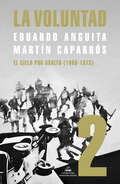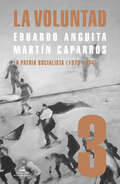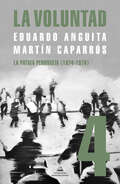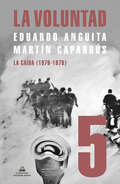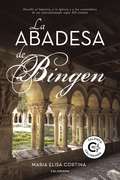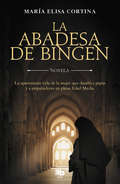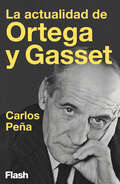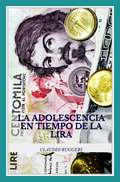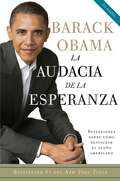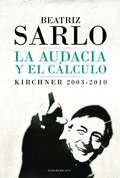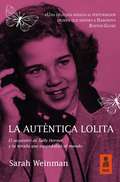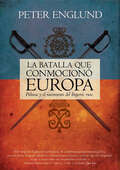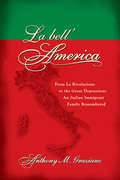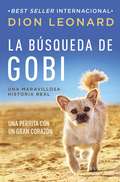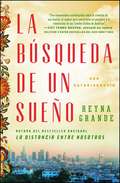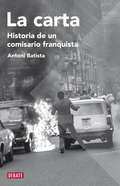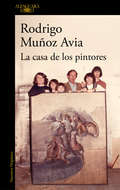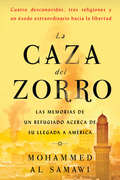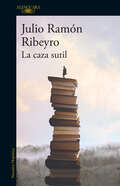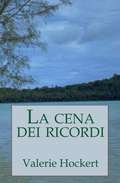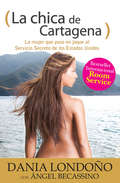- Table View
- List View
La Voluntad 2. El cielo por asalto (1969 - 1973)
by Martín Caparrós Eduardo AnguitaEntre la vida y la muerte, un retrato profundo del día a día de los jóvenes revolucionarios de los 70 y un momento excepcional de la historia argentina. «La Voluntad es un intento de reconstrucción histórica de la militancia política en la Argentina en los años sesenta y setenta. Y, también, la tentativa de ofrecer un panorama general de la cultura y la vida en esos años. La Voluntad es la historia de una cantidad de personas, muy distintas entre sí, que decidieron arriesgar todo lo que tenían para construir una sociedad que consideraban más justa. Elegimos las historias que la componen para que ofrecieran un cuadro de las corrientes y los espacios sociales de la época. La elección siempre se puede discutir; por otro lado, no todos los que contactamos quisieron dar su testimonio. Pero creemos que la veintena de relatos que se cruzan en su trama muestran cómo eran la vida cotidiana, los intereses, odios, convicciones, objetivos, miedos y satisfacciones de los que eligieron ese camino.»Los autores Una historia de la militancia revolucionaria en la Argentina 1969-1973 Radicales, peronistas, marxistas, comunistas... Los jóvenes militantes que protagonizan esta obra provienen de distintas clases sociales, pero comparten una época absolutamente singular. De la misión espacial que llega a la Luna a la locura desatada por Los Beatles, de la centralidad de la televisión a las expresiones vanguardistas del arte del Instituto Di Tella, del Che Guevara a los curas tercermundistas, el feminismo, el psicoanálisis... De la lucha política a veces sangrienta y casi siempre multitudinaria en calles y plazas al debate ideológico que reconfigura las formas tradicionales de concebir no solo la sociedad, sino también las relaciones de pareja, la sexualidad y la individualidad. Martín Caparrós y Eduardo Anguita consiguen la hazaña de dar cuenta de toda esa riqueza de experiencias históricas a partir de un conjunto de vidas singulares y verterlas al lenguaje de una novela que no se puede dejar de leer. La crítica ha dicho... «Es una obra indispensable. Buena parte de la narrativa de ficción sobre los setentas tiene en La Voluntad una cantera muy importante.»Guillermo Saccomanno «Hay que entender el entusiasmo de esos años, leyendo al pie de la letra los testimonios.»Beatriz Sarlo, Punto de Vista «La edición definitiva de La Voluntad, de Eduardo Anguita y Martín Caparrós, pone en perspectiva lo que significó su publicación hace quince años, cuando por primera vez apareció una historia de la militancia revolucionaria en la Argentina sin eufemismos, una apuesta a combatir la desmemoria desde la escritura.»Mora Cordeu, Télam «Más allá del enorme valor que tuvo en su momento, y que por supuesto mantiene, La Voluntad permite comparar el impacto de una misma historia desde dos contextos. Nadie que haya leído este libro en su primera edición y lo relea hoy lo verá con los mismos ojos. Es otro el mirador de la historia.»Revista Ñ «(La Voluntad) tiene el indudable mérito de haber puesto en primer plano el pasado militante de los detenidos/desaparecidos, que hasta el momento se habían visto aprisionados en su papel de "víctimas".»María Virginia Castro
La Voluntad 3. La patria socialista (1973 - 1974)
by Martín Caparrós Eduardo AnguitaEntre la vida y la muerte, un retrato profundo del día a día de los jóvenes revolucionarios de los 70 y un momento excepcional de la historia argentina. «La Voluntad es un intento de reconstrucción histórica de la militancia política en la Argentina en los años sesenta y setenta. Y, también, la tentativa de ofrecer un panorama general de la cultura y la vida en esos años. La Voluntad es la historia de una cantidad de personas, muy distintas entre sí, que decidieron arriesgar todo lo que tenían para construir una sociedad que consideraban más justa. Elegimos las historias que la componen para que ofrecieran un cuadro de las corrientes y los espacios sociales de la época. La elección siempre se puede discutir; por otro lado, no todos los que contactamos quisieron dar su testimonio. Pero creemos que la veintena de relatos que se cruzan en su trama muestran cómo eran la vida cotidiana, los intereses, odios, convicciones, objetivos, miedos y satisfacciones de los que eligieron ese camino.»Los autores Una historia de la militancia revolucionaria en la Argentina 1973-1974 El breve período que va de la asunción presidencial de Héctor J. Cámpora el 25 de mayo de 1973 a la muerte de Juan Domingo Perón, su mentor y sucesor, el 1° de julio del año siguiente, marcan el apogeo y ocaso de un sueño. La pesadilla ya se había anunciado en Ezeiza, cuando un sector del justicialismo emboscó y tiroteó a la izquierda del movimiento, que también recibía a su líder después del largo exilio. En esos pocos meses, el vértigo de los acontecimientos cambia el signo ideológico de la época y erosiona a la patria socialista. La velocidad de esos días decisivos -acelerados por el triunfo aplastante de la fórmula Perón-Perón en las urnas y el asesinato de Ignacio Rucci por parte de Montoneros poco después- tiene en Martín Caparrós y Eduardo Anguita a sus mejores cronistas. La crítica ha dicho... «Es una obra indispensable. Buena parte de la narrativa de ficción sobre los setentas tiene en La Voluntad una cantera muy importante.»Guillermo Saccomanno «Hay que entender el entusiasmo de esos años, leyendo al pie de la letra los testimonios.»Beatriz Sarlo, Punto de Vista «La edición definitiva de La Voluntad, de Eduardo Anguita y Martín Caparrós, pone en perspectiva lo que significó su publicación hace quince años, cuando por primera vez apareció una historia de la militancia revolucionaria en la Argentina sin eufemismos, una apuesta a combatir la desmemoria desde la escritura.»Mora Cordeu, Télam «Más allá del enorme valor que tuvo en su momento, y que por supuesto mantiene, La Voluntad permite comparar el impacto de una misma historia desde dos contextos. Nadie que haya leído este libro en su primera edición y lo relea hoy lo verá con los mismos ojos. Es otro el mirador de la historia.»Revista Ñ «(La Voluntad) tiene el indudable mérito de haber puesto en primer plano el pasado militante de los detenidos/desaparecidos, que hasta el momento se habían visto aprisionados en su papel de "víctimas".»María Virginia Castro
La Voluntad 4. La patria peronista (1974 - 1976)
by Martín Caparrós Eduardo AnguitaEntre la vida y la muerte, un retrato profundo del día a día de los jóvenes revolucionarios de los 70 y un momento excepcional de la historia argentina. «La Voluntad es un intento de reconstrucción histórica de la militancia política en la Argentina en los años sesenta y setenta. Y, también, la tentativa de ofrecer un panorama general de la cultura y la vida en esos años. La Voluntad es la historia de una cantidad de personas, muy distintas entre sí, que decidieron arriesgar todo lo que tenían para construir una sociedad que consideraban más justa. Elegimos las historias que la componen para que ofrecieran un cuadro de las corrientes y los espacios sociales de la época. La elección siempre se puede discutir; por otro lado, no todos los que contactamos quisieron dar su testimonio. Pero creemos que la veintena de relatos que se cruzan en su trama muestran cómo eran la vida cotidiana, los intereses, odios, convicciones, objetivos, miedos y satisfacciones de los que eligieron ese camino.»Los autores Una historia de la militancia revolucionaria en la Argentina 1974-1976 ¿Cómo se llega al golpe del 24 de marzo de 1976, la herida que marcaría para siempre un antes y un después en la historia del país? Para entenderlo, Martín Caparrós y Eduardo Anguita siguen el día a día de un grupo de militantes populares desde la muerte de Juan Domingo Perón hasta el derrocamiento de su viuda, Isabel Martínez. Entonces, el poder había quedado en manos López Rega, que despliega sus mortíferos escuadrones de la AAA. Las torturas, los secuestros ylos asesinatos provocan el exilio de artistas, intelectuales y militantes, y anuncian la maquinaria de la desaparición del Terrorismo de Estado. La violencia se impone en todos los aspectos de la vida pública y la tragedia va alcanzando, de un modo u otro, a los protagonistas. La crítica ha dicho... «Es una obra indispensable. Buena parte de la narrativa de ficción sobre los setentas tiene en La Voluntad una cantera muy importante.»Guillermo Saccomanno «Hay que entender el entusiasmo de esos años, leyendo al pie de la letra los testimonios.»Beatriz Sarlo, Punto de Vista «La edición definitiva de La Voluntad, de Eduardo Anguita y Martín Caparrós, pone en perspectiva lo que significó su publicación hace quince años, cuando por primera vez apareció una historia de la militancia revolucionaria en la Argentina sin eufemismos, una apuesta a combatir la desmemoria desde la escritura.»Mora Cordeu, Télam «Más allá del enorme valor que tuvo en su momento, y que por supuesto mantiene, La Voluntad permite comparar el impacto de una misma historia desde dos contextos. Nadie que haya leído este libro en su primera edición y lo relea hoy lo verá con los mismos ojos. Es otro el mirador de la historia.»Revista Ñ «(La Voluntad) tiene el indudable mérito de haber puesto en primer plano el pasado militante de los detenidos/desaparecidos, que hasta el momento se habían visto aprisionados en su papel de "víctimas".»María Virginia Castro
La Voluntad. La caída (1976 - 1978)
by Martín Caparrós Eduardo AnguitaEntre la vida y la muerte, un retrato profundo del día a día de los jóvenes revolucionarios de los 70 y un momento excepcional de la historia argentina. «La Voluntad es un intento de reconstrucción histórica de la militancia política en la Argentina en los años sesenta y setenta. Y, también, la tentativa de ofrecer un panorama general de la cultura y la vida en esos años. La Voluntad es la historia de una cantidad de personas, muy distintas entre sí, que decidieron arriesgar todo lo que tenían para construir una sociedad que consideraban más justa. Elegimos las historias que la componen para que ofrecieran un cuadro de las corrientes y los espacios sociales de la época. La elección siempre se puede discutir; por otro lado, no todos los que contactamos quisieron dar su testimonio. Pero creemos que la veintena de relatos que se cruzan en su trama muestran cómo eran la vida cotidiana, los intereses, odios, convicciones, objetivos, miedos y satisfacciones de los que eligieron ese camino.»Los autores Una historia de la militancia revolucionaria en la Argentina 1976-1978 Muy cerca del Estadio Monumental, donde se jugaban los partidos del Mundial 78, funcionaba la ESMA, uno de tantos centros clandestinos de detención y muerte. Allí no solo se torturaba y mataba; también se operaban los vuelos que lanzaban a sus víctimas vivas al Río de la Plata. Para entonces, miles de militantes trataban de subsistir en la clandestinidad; muchos habían sido secuestrados o asesinados. Enfrentadas y diezmadas, las cúpulas revolucionarias toman decisiones impracticables y no consiguen levantar al pueblo contra un gobierno ilegítimo y violento, cuyo plan económico destruye la industria nacional e inicia el ciclo nefasto del endeudamiento externo. Esta saga monumental culmina entre los gritos de júbilo del triunfo mundialista. Para llegar a escuchar los gritos de dolor harían falta años. Y libros fundamentales como este, que recuperaran las historias de los perseguidos. La crítica ha dicho... «Es una obra indispensable. Buena parte de la narrativa de ficción sobre los setentas tiene en La Voluntad una cantera muy importante.»Guillermo Saccomanno «Hay que entender el entusiasmo de esos años, leyendo al pie de la letra los testimonios.»Beatriz Sarlo, Punto de Vista «La edición definitiva de La Voluntad, de Eduardo Anguita y Martín Caparrós, pone en perspectiva lo que significó su publicación hace quince años, cuando por primera vez apareció una historia de la militancia revolucionaria en la Argentina sin eufemismos, una apuesta a combatir la desmemoria desde la escritura.»Mora Cordeu, Télam «Más allá del enorme valor que tuvo en su momento, y que por supuesto mantiene, La Voluntad permite comparar el impacto de una misma historia desde dos contextos. Nadie que haya leído este libro en su primera edición y lo relea hoy lo verá con los mismos ojos. Es otro el mirador de la historia.»Revista Ñ «(La Voluntad) tiene el indudable mérito de haber puesto en primer plano el pasado militante de los detenidos/desaparecidos, que hasta el momento se habían visto aprisionados en su papel de "víctimas".»María Virginia Castro
La abadesa de Bingen
by María Elisa CortinaHildegarda de Bingen desafió al Imperio, a la Iglesia y a las costumbres de un convulsionado siglo XII alemán. Nacida en una familia de fortuna y linaje, a los tres años de edad Hildegarda de Bingen comenzó a tener visiones acompañadas de dolores tan intensos que parecían llevarla a la muerte. <P><P>A los catorce años fue encerrada, contra su voluntad, en una celda de barro adosada a las paredes de un monasterio de varones. Allí dedicaría su vida solo a la contemplación del Señor. Pero Dios le tenía preparada otra cosa. Sazonada con ingredientes fantásticos y usando como telón de fondo el mundo monástico y el convulsionado siglo XII, esta novela narra la historia de esa joven que desafiando a su mundo fue abadesa, profetisa y médico. <P>Realizó milagros y exorcismos, se vistió con sedas y joyas, escribió de teología y medicina, compuso música, fundó dos monasterios, predicó en público, desafió al mundo masculino y enfrentó a papas yemperadores siendo una de las personalidades más fascinantes del siglo XII alemán.
La abadesa de Bingen
by María Elisa CortinaLa verdadera historia de la mujer que desafió a papas y emperadores en plena Edad Media. Nacida en una familia de fortuna y linaje, a los tres años de edad Hildegarda de Bingen comenzó a tener visiones acompañadas de dolores tan intensos que parecían llevarla a la muerte. A los catorce años fue encerrada, contra su voluntad, en una celda de barro adosada a las paredes de un monasterio de varones. Allí dedicaría su vida solo a la contemplación del Señor. Pero Dios le tenía preparada otra cosa. Sazonada con ingredientes fantásticos y usando como telón de fondo el mundo monástico y el convulsionado siglo XII, esta novela narra la historia de esa joven que desafiando a su mundo fue abadesa, profetisa y médico. Realizó milagros y exorcismo, se vistió con sedas y joyas, escribió de teología y medicina, compuso música, fundó dos monasterios, predicó en público, desafió al mundo masculino y enfrentó a papas y emperadores siendo una de las personalidades más fascinantes del siglo XII alemán. **Novela ganadora del Premio Caligrama 2018, en la categoría Talento.**
La abadesa de Bingen
by María Elisa CortinaLa verdadera historia de la mujer que desafió a papas y emperadores en plena Edad Media. Nacida en una familia de fortuna y linaje, a los tres años de edad Hildegarda de Bingen comenzó a tener visiones acompañadas de dolores tan intensos que parecían llevarla a la muerte. A los catorce años fue encerrada, contra su voluntad, en una celda de barro adosada a las paredes de un monasterio de varones. Allí dedicaría su vida solo a la contemplación del Señor. Pero Dios le tenía preparada otra cosa. Sazonada con ingredientes fantásticos y usando como telón de fondo el mundo monástico y el convulsionado siglo XII, esta novela narra la historia de esa joven que desafiando a su mundo fue abadesa, profetisa y médico. Realizó milagros y exorcismo, se vistió con sedas y joyas, escribió de teología y medicina, compuso música, fundó dos monasterios, predicó en público, desafió al mundo masculino y enfrentó a papas y emperadores siendo una de las personalidades más fascinantes del siglo XII alemán.**Novela ganadora del Premio Caligrama 2018, en la categoría Talento.**
La actualidad de Ortega y Gasset
by Carlos PeñaUna invitación a descubrir la trayectoria vital e intelectual del pensador y ensayista más moderno, estimulante y perdurable de la España del siglo XX. «Si hubiera sido francés, sería Sartre; si inglés, Russell; si alemán, Heidegger.Pero fue español. Se llamaba José Ortega y Gasset.» Ortega y Gasset es uno de esos nombres que todos conocemos, pero del que poco podemos decir al respecto. Lo mismo pasa con otros gigantes de la filosofía como Descartes, Kant o Hegel. En este texto, Carlos Peña, doctor en Filosofía y rector de la Universidad Diego Portales, pone remedio al desconocimiento general de este autor y ofrece una aproximación cuidada y rigurosa a su trayectoria a la vez que reivindica la importancia del pensamiento de José Ortega y Gasset a pesar de sus claroscuros. Hijo de su tiempo y de sus circunstancias, Ortega y Gasset consiguió algo muy difícil: que brotasenideas filosóficas en una España en crisis. Fue un pensador público que confiaba en sustraer el discurso filosófico de la academia y el lenguaje elevado para acercarlo a las plazas y a su gente. Por eso nunca dudó ante la oportunidad de tomar la palabra en público e iluminar a su audiencia sobre cualquier tema. Defensor de la idea de Europa, su trabajo demuestra el compromiso vital por construir una España activa y despierta, llena de ideas y apostando por una acérrima obertura de europeización de la cultura española. Es tarea nuestra, leyéndolo y transmitiendo la validez y actualidad de su pensamiento, evitar que el gran Ortega y Gasset caiga en el olvido, porque filósofos de tal calibre no se encuentran cada día. Reseñas:«No siempre se le puede mirar de frente, no siempre se le puede interpretar con la razón racionalista. Hay que entenderlo poéticamente, hay que mirarlo de soslayo, hay que mirar sus sentimientos. No es solo un ente racional».Javier Zamora «Una personalidad muy incómoda para el régimen franquista y muy admirada por los universitarios y por la intelectualidad extranjera».Nieves Concostrina «El suyo fue un pensamiento disruptivo, un ejercicio a contracorriente. [...] Ortega era, además, un tipo que comprendía que los intransigentes no son quienes tienen una mayor estima por sus propias ideas. [...] El conjunto de su obra se caracteriza más bien por disparar, desprejuiciado y sin trinchera, contra todo y contra todos».Gonzalo Cachero, Ethic
La adolescencia en tiempo de la lira
by Claudio Ruggeri Jelmer Alexander de Kok BernatEl encuentro de dos amigos una tarde de verano, en el cual el más jóven escuchará las anécdotas del otro de un mundo ya desaparecido y que no volverá a existir, en el que se escuchaba mucho la frase "No tengo una lira".
La audacia de la esperanza
by Barack ObamaEn La audacia de la esperanza, el senador demócrata Barack Obama reclama una política diferenteuna política para quienes están cansados del agrio partidismo, una política que se basa en la fe, la participación de todos y la nobleza de espíritu que es parte esencial de nuestro improbable proyecto de democracia. En el corazón de este libro está la visión del senador Obama de cómo podemos superar nuestras divisiones para enfrentar los problemas concretos. Él examina la creciente inseguridad económica de las familias estadounidenses, las tensiones raciales y religiosas dentro del cuerpo político y las amenazas transnacionalesdesde el terrorismo hasta las pandemiasque se congregan más allá de nuestras costas. En sus anécdotas acerca de su familia, amigos, miembros del Senado y hasta del presidente, existe un poderoso deseo de establecer conexiones: la plataforma de un consenso político radicalmente optimista. Como senador y abogado, profesor y padre, cristiano y escéptico, y sobre todo como estudioso de la historia y de la naturaleza humana, el senador Obama ha escrito un libro de un poder transformador.
La audacia y el cálculo: Kirchner 2003-2010
by Beatriz Sarlo«Si alguien busca un panfleto, no lo encontrará en este libro», avisaBeatriz Sarlo a poco de comenzar, advertencia que cobra la fuerza de unarevelación con el correr de las páginas. A Kirchner lo define un hazcontradictorio: concentración, velocidad e inteligencia; tenacidad,conocimiento e impericia; fortuna y sangre fría; mezquindad con laoposición, sectarismo, encierro. Despótico, decidido, autoritario, valiente, rápido, ambicioso, sectario,inteligente, hipócrita... Los adjetivos pueden apilarse sobre eldifunto ex presidente pero, antes de calificar, Sarlo prefiere relatarlos hechos, revisarlos desde el mismo comienzo, como el mejor modo decomprenderlos. De qué manera Kirchner construyó poder -la multiplicaciónde la fortuna personal como garantía de que, incluso perdiendoelecciones, siempre estaría armado para volver-, ganó porciones del PJ einspiró un raro misticismo en los progresistas. Gran calculador y sinembargo audaz, peleó todas las batallas e ignoró el retroceso. «Hay detodo en estos años. Episodios de corrupción funambulesca; uso delpresupuesto nacional y de los planes asistenciales para mantener lalealtad territorial de jefes políticos o sociales; cooptación y manodura, adulaciones y ninguneos, peleas y reconciliaciones; un aparato dereparto de recursos que pasa por encima de las autonomías provinciales;la inflación disfrazada por razones políticas, lo que implica ignorarla pobreza que genera; el apoyo a la ciencia y la tecnología y, ensentido opuesto, la destrucción del INDEC. También hay que incorporar albalance el equilibrio presupuestario, la afirmación de la soberanía enla toma de decisiones, la amistad con Chávez pero también con España,Chile y Brasil; la política de derechos humanos respecto del pasado».
La auténtica Lolita: El secuestro de Sally Horner y la novela que escandalizó al mundo
by Sarah Weinman«Lolita», de Vladimir Nabokov, una de las novelas más apreciadas y célebres de todos los tiempos, se inspira en un caso real: el secuestro en 1948 de Sally Horner, una niña de once años. «La auténtica Lolita» cuenta por primera vez la historia de Sally Horner de forma completa aunando una intrigante narración del crimen, contexto cultural y social e investigación literaria. Sarah Weinman realiza una apasionante y meticulosa investigación literaria, que incluye documentos jurídicos, archivos públicos y entrevistas con familiares, para desvelar cuánto sabía Nabokov sobre el caso de Sally Horner y su intento por ocultar ese conocimiento durante el proceso de escritura y edición de «Lolita». La autora analiza de forma exhaustiva las vicisitudes de la publicación de Lolita y sitúa a Sally Horner en el lugar que le corresponde: en el centro de la creación de la novela. «La auténtica Lolita», cautivadora y desgarradora, arroja nueva luz sobre el origen de un clásico moderno.
La batalla que conmocionó Europa: Poltava y el nacimiento del Imperio Ruso
by Peter EnglundPoltava y el nacimiento del Imperio Ruso. La batalla de Poltava en 1709 marca el nacimiento del Imperio ruso de Pedro el Grande. En 1700, el zar, de acuerdo con Dinamarca, Sajonia y Polonia, decidió acabar con la hegemonía sueca del norte de Europa. Cuando estas fuerzas internacionales consiguieron derrotar a las tropas del rey Carlos XII en Poltava, Ucrania, empezó el principio del declive y colapso del Imperio sueco y el ascenso de Rusia.Junio de 1709. La guerra dura ya nueve largos años, y el ejército de Carlos XII sitia la ciudad de Poltava, en Ucrania. La caravana a Moscú se ha detenido, y el ejército ruso bajo las órdenes del zar Pedro está solo a cuatro kilómetros de distancia. Los suecos se han estado preparando para la batalla y las tropas, que habían estado desperdigadas por las llanuras de Ucrania, se han congregado. El plan consiste en marchar al amparo de la oscuridad y pillar a los rusos por sorpresa, pero cuando sale el sol todo el plan se desbarata.En este libro se retrata el golpe fatal, hora tras hora, la catástrofe que sesgó 10000 vidas. Se analizan las estrategias en el campo de batalla, los detalles que hacen la historia comprensible, real. A través de los diarios y cartas de los testigos, lo sucedido se llena de las voces de los que estaban allí: el general, sus sirvientes, soldados, el capellán y la viuda de un soldado...
La bell'America
by Anthony M. Graziano"This is a delightful, passionate and memorable rendition of a familiar and glorious tale. As the son of immigrants who were very much like Anthony Graziano's family, I was especially moved. Thank you for telling our story."-Governor Mario M. Cuomo"This kind of historical data is rare today. . . . A tapestry of history, biography, personal reminiscence, and lessons."-Michael Giallombardo, director/producer of La Terra Promessa"A sweeping narrative of European and American history, and a lovingly crafted reminiscence. Graziano is an excellent storyteller. There is something in this book for everyone, not least of which is a very good read."-Joan M. Crouse, author of The Homeless Transient in the Great Depression"Writing in the tradition of C. Wright Mills, who defined [sociology] as the intersection between history and biography . . . this book clarifies the tremendous emigration from Italy. A very enjoyable read, suitable for general readers and students of history and sociology."-Adeline Levine, author of Love Canal: Science, Politics, and PeopleA picture of Europe's nineteenth century and the massive Italian immigration to America: wars and conflicts, popes and kings fighting the people's demands for democratic government. When religion and royalty failed them, leaders created dictatorships and threw the world into bloody conflicts, killing hundreds of millions and virtually destroying Europe. Caught up were the poverty stricken, powerless common people who became the immigrants, pushed from Europe, pulled to America. Their history comes alive in the author's deeply personal account of his family's immigration and survival through the Great Depression.Anthony M. Graziano, SUNY Buffalo professor emeritus and Italian chef, has written fifteen books and fifty articles in the field of psychology. His brother, parents, and extended family emigrated from Italy. He says, "This book is a celebration of immigrants. It speaks to us because we are all immigrants."
La búsqueda de Gobi: Un perrrita con un gran corazón (Una maravillos historia real)
by Dion LeonardLa búsqueda de Gobi es la milagrosa historia de Dion Leonard, un corredor de ultramaratones experimentado que se encontró con una perrita callejera mientras competía en una carrera de 155 millas a través del desierto de Gobi en China. La adorable cachorro, que luego nombró «Gobi», demostró que lo que le faltaba en tamaño, lo compensaba con el corazón. Gobi recorrió junto a Dion gigantescas dunas de arena y atravesó las montañas Tian Shan, aldeas y las arenas negras del desierto de Gobi, manteniendo el ritmo con él durante casi ochenta millas. Dion fue testigo de la increíble determinación y corazón de Gobi, y se dio cuenta que su propio corazón experimentaba también un cambio. Dion permitía que Gobi durmiera en su tienda de campaña por las noches, le compartía agua y alimentos de sus propias provisiones limitadas, a veces también la cargaba, aun sabiendo que eso significaba retrasarse en la carrera, o peor aún, le impedería terminar en absoluto. En las carreras anteriores de Dion, él se enfocaba en ganar y ser el mejor, pero esta vez su objetivo era asegurarse que su amistad con Gobi continuara mucho después de llegar a la meta. Sin embargo, antes de que pudiera llevarla a casa, Gobi desapareció en una inmensa ciudad china. Con la ayuda de desconocidos y el apoyo de gente alrededor del mundo, Dion inició la búsqueda para reencontrar al asombroso animal que le demostró a él y al mundo entero que los milagros son posibles.
La búsqueda de un sueño: Una autobiografía (Atria Espanol)
by Reyna GrandeLa extraordinaria historia de Reyna Grande—que comenzó en su exitosa autobiografía La distancia entre nosotros—continúa ahora en esta fabulosa travesía para encontrar su lugar en los Estados Unidos como universitaria latina de primera generación y como escritora.Reyna Grande tenía nueve años cuando cruzó la frontera de México y los Estados Unidos buscando un hogar y el reencuentro con sus padres, quienes la habían dejado en su tierra natal para migrar a Los Ángeles en busca de una mejor vida. Sin embargo, lo que encontró fue a una madre indiferente y a un padre alcohólico y violento, en un país cuyo sistema educativo menospreciaba sus raíces. Reyna se refugió en las palabras. Su amor por la lectura y la escritura fueron su inspiración para salir adelante y lograr lo que parecía imposible: ser la primera persona en su familia en asistir a la universidad. Pero la experiencia universitaria resultó intimidante, y muy pronto descubrió que desconocía lo que se requiere para forjar una carrera a partir de un sueño. Contra viento y marea, Reyna convirtió su condición de inmigrante indocumentada en la de “una escritora valiente, inteligente y brillante” (Cheryl Strayed, autora de Wild) que “habla por millones de inmigrantes cuyas voces no han sido escuchadas” (Sandra Cisneros, autora de La casa en Mango Street). Narrada con esa prosa conmovedora y sincera que la caracteriza, en La búsqueda de un sueño Reyna Grande nos relata cómo persiguió sus sueños para construir lo que siempre había anhelado: un hogar duradero.
La cabalgata nocturna de Sybil Ludington (¡Arriba la Lectura!, Level P #70)
by James Watling Marlene Pérez Joe LemonnierMuchos valientes trabajaron para liberarnos de los británicos. Entre ellos había una niña llamada Sybil. Lee sobre su cabalgata nocturna. NIMAC-sourced textbook
La cara oculta de Eva: La mujer en los países árabes
by Nawal El Saadawi«La cara oculta de Eva», un clásico de la literatura árabe moderna, denuncia la opresión que sufren las mujeres en el mundo islámico y, con unos nuevos prólogo y epílogo, mantiene toda su vigencia más de veinticinco años después de su publicación. Nawal El Saadawi relata de manera impactante la violencia y la injusticia que se han extendido por la sociedad en la que vive. Su experiencia como médico rural en distintas zonas de Egipto, como testigo de la prostitución, de los asesinatos por razones de honor y de los abusos sexuales, además de la ablación, que ella misma sufrió de niña, la impulsaron a dar testimonio de todo este sufrimiento. Con claridad y precisión detecta y analiza las causas de esta situación, y describe el papel histórico de la mujer árabe en la religión y la literatura. Para la autora, el velo, la poligamia y la falta de igualdad ante la ley de hombres y mujeres son incompatibles con el islam y con cualquiera de las otras religiones.
La carta: Historia de un comisario franquista
by Antoni BatistaLa historia del comisario franquista Juan Creix: una crónica histórica esencial para comprender las tensiones de un régimen en descomposición. Quizá el hecho más destacado de la biografía de Juan Creix sea haberse convertido en el único mando de la policía política franquista depurado antes de la muerte del dictador. En los estertores de la dictadura, los sectores moderados del régimen necesitaban posicionarse para el pacto inevitable de la Transición, y el comisario Creix constituía un grave problema: era el arquetipo de la represión contra esos demócratas con los que tendrían que entenderse en un futuro próximo. La reacción de Creix se encuentra en este libro: escribe una larga carta en la que relata sus servicios al régimen y la envía a quienes pueden ayudarle. En ella traza una completa historia de la represión a modo de biografía epistolar y da cuenta de sus operaciones más importantes: en Cataluña detenciones de comunistas y anarquistas y destacadas operaciones contra el movimiento obrero y estudiantil; en el País Vasco arrestos de los miembros de ETA que han matado a Melitón Manzanas, su antecesor, sentando en el banquillo a los encausados en el Proceso de Burgos; en Sevilla, adonde le llevan sus éxitos en Euskadi como jefe superior de Policía de Andalucía, se ha enfrentado a Comisiones Obreras y a un notorio delincuente común: el Lute. Su carta es un testimonio excepcional que ha permitido a Antoni Batista trazar un bosquejo de la durísima represión sufrida por quienes se enfrentaron a la dictadura y un retrato psicológico del que fue uno de sus principales comisarios.
La casa de los pintores
by Rodrigo Muñoz AviaEl relato personal, lleno de emoción y amor, de dos artistas contemporáneos de primer nivel, los pintores Lucio Muñoz y Amalia Avia, vistos a través de la mirada de su hijo. «En este libro hablo de quiénes fueron mis padres y cómo fue mi vida con ellos. Uno debe escribir de aquello que más sabe, debe compartir, de la manera más honesta que sea capaz, la mejor historia que lleve dentro. En este momento esta era mi mejor historia, la de mis padres, la de mi origen. »Siempre he creído que en buena parte estoy hecho de pintura. Mis padres eran artistas plásticos y se conocieron y se enamoraron gracias a la pintura. En nuestra casa y en nuestra vida familiar la pintura estaba por todas partes. No había un espacio para ser pintores y un espacio para ser padres o para ser hijos. Todo estaba unido. Éramos hijos de la pintura. »Yo pasaba tardes enteras viéndolos trabajar en sus estudios, fascinado por el aspecto plástico y artesanal de su oficio. Me encantaba tener a unos padres tan diferentes a los de mis compañeros de colegio y dejaba que el aura que envolvía su trabajo creativo, con el reconocimiento que empecé a descubrir que tenía, me envolviera también a mí, como si el ser hijo de ellos fuera un mérito mío. Quería y admiraba mucho a mis padres, con sus personalidades tan diferentes y tan singulares, y deseaba quedarme todo el tiempo en su mundo fabuloso de artistas, de conversaciones y reivindicaciones políticas, de cenas, de viajes, de exposiciones aquí y allí. »El día en que murieron, mi padre en 1998 y mi madre en 2011, descubrí que yo no estaba hecho solo de pintura. La muerte no se llevó a los artistas, pero sí a las personas. El artista sobrevive, perdura para todos, pero el hijo que yo era había perdido a sus padres. Este libro trata de recuperar a esas personas y compartirlas con los demás.»Rodrigo Muñoz Avia La crítica ha dicho sobre el autor y sus obras:«Cactus, además de un viaje iniciático a una tierra prometida, [...] es el descubrimiento, con enorme carga poética, del paisaje norteamericano para disfrute de las nuevas generaciones.»Juan Ángel Juristo, ABC «Una lectura enormemente divertida y propensa a la carcajada.»Fernando Díaz de Quijano, El Cultural (sobre Cactus) «Todo esto lo cuenta Muñoz Avia con chispa e ingenio [...]. Novela, para nuestra suerte, salpicada con escenas de antología.»Antonio Fontana, ABC de las Artes y las Letras (sobre Psiquiatras, psicólogos y otros enfermos) «En la gracia y el ingenio derramado en algunas situaciones radica lo mejor del texto.»Ángel Basanta, El Cultural (sobre Psiquiatras, psicólogos y otros enfermos) «Este es uno de esos relatos que, envueltos en un papel de colores, guardan en su interior los elementos necesarios para comprobar los matices que hacen de la vida una experiencia muy original [...]. Un libro para reír pensando, o pensar riendo, mas para hacerlo uno mismo, sin ayuda profesional.»Antonio J. Ubero, Diario de Valencia (sobre Psiquiatras, psicólogos y otros enfermos)
La caza del zorro: Las memorias de un refugiado acerca de su llegada a America
by Mohammed Al SamawiLa historia conmovedora de un joven y su escape angustiante de una cruenta guerra civil en Yemen gracias a un plan urdido en las redes sociales por un pequeño grupo interconfesional de activistas del Oeste. Mohammed Al Samawi era un musulmán devoto que consideraba a los cristianos y los judíos como el enemigo. Pero después de leer una Biblia y conectarse con judíos y cristianos en las redes sociales, Mohammed se convierte en activista, con la misión de promover el diálogo y la cooperación en Yemen. Y entonces llegan las amenazas de muerte: primero por medio de Facebook y luego por llamadas telefónicas anónimas. Para proteger a su familia y a sí mismo, Mohammed huye al sur, a la ciudad portuaria de Adén. No podría saber que Adén estaba por convertirse en el corazón de la guerra civil entre el norte y el sur, el campo de batalla para una guerra subsidiaria financiada por terceros: Irán y Arabia Saudita. Al estallar los tiroteos y detonar las granadas a lo largo de la ciudad, Mohammed se esconde en el baño de su departamento y desesperadamente clama a sus contactos de Facebook. Por milagro, responde un puñado de personas que apenas conoce. Durante trece días, cuatro jóvenes comunes y corrientes, con nada de experiencia en absoluto en lo que se refiere a la diplomacia o estrategia militar, utilizan seis plataformas de tecnología y trabajan a través de diez husos horarios para rescatar a ese joven inocente atrapado entre fuerzas mortales. A young man’s moving story of war, friendship, and hope in which he recounts his harrowing escape from a brutal civil war in Yemen with the help of a daring plan engineered on social media by a small group of interfaith activists in the West. Mohammed Al Samawi was a devout Muslim raised to think of Christians and Jews as his enemy. But when Mohammed was twenty-three, he secretly received a copy of the Bible, and what he read cast doubt on everything he’d previously believed. After connecting with Jews and Christians on social media, and at various international interfaith conferences, Mohammed became an activist, making it his mission to promote dialogue and cooperation in Yemen. Then came the death threats: first on Facebook, then through terrifying anonymous phone calls. To protect himself and his family, Mohammed fled to the southern port city of Aden. He had no way of knowing that Aden was about to become the heart of a north-south civil war, the battleground for a well-funded proxy war between Iran and Saudi Arabia. As gunfire and grenades exploded throughout the city, Mohammed hid in the bathroom of his apartment and desperately appealed to his contacts on Facebook. Miraculously, a handful of people he barely knew responded. Over thirteen days, four ordinary young people with zero experience in diplomacy or military exfiltration worked across six technology platforms and ten-time zones to save this innocent young man trapped between deadly forces.
La caza sutil: (1953-1994)
by Julio Ramón Ribeyro"[Este libro] no pretende ser un safari por los dominios de la crítica literaria, sino un desaprensivo paseo entre libros y autores, recogiendo aquí y allá una que otra pequeña presa". Julio Ramón Ribeyro
La cena dei ricordi
by Valerie Hockert Nicole StellaUna donna di mezza età ha recentemente perso il marito. Pensa che la propria vita sia ormai priva di significato e che lei sia inutile. Conserva dei ricordi in una scatola, quando le viene l'idea di organizzare una cena e di chiedere agli invitati di portare un oggetto che li aiuti a ricordare qualcosa--un fazzoletto, un gioiello, un piccolo strumento, un souvenir, un bottone, una locandina o qualsiasi altro articolo. L'idea è di far raccontare a ciascun invitato la storia dietro l'oggetto. Di certo non si aspetta che alcuni ospiti abbiano segreti così sorprendenti legati al proprio ricordo. Una vita precedente, un figlio perso, un incidente--molti provano tristezza di fronte al proprio oggetto, ma l'hanno comunque conservato per mantenere un contatto con la realtà. Dopo aver ascoltato tutte quelle storie tristi, la donna capisce che la sua vita non è poi così brutta e che il suo scopo, ora, è l'amicizia verso queste persone.
La chica de Cartagena: La mujer que puso en jaque al Servicio Secreto de los Estados Unidos
by Dania LondoñoLa mujer que puso en jaque al Servicio Secreto de los Estados Unidos El único libro que revelará la historia completa de Dania Londoño, contada por ella misma. -El libro que no dejará espacio a preguntas sobre la verdadera procedencia de Dania Londoño, y que terminará por cerrar una historia que despertó la curiosidad, el morbo y la moral de millones de personas en el mundo. -El apoyo del escritor Angel Becassino permite darle al libro una narración digna de un libro publicado bajo el sello Aguilar. Dania Londoño se convirtió en pocos días en una de las mujeres más buscadas y solicitadas por los medios de comunicación del mundo entero. Su paso por una habitación de un hotel de Cartagena en compañía de uno de los guardias de seguridad del Presidente Barack Obama la convirtió en el escándalo mundial del momento. En este libro Dania Londoño revela los más exactos detalles de quésucedió aquella noche entre ella y el agente de seguridad, por qué terminaron en la habitación de ese hotel y todo aquello que ha dejado de contar Dania y se ha reservado para contarlo en este libro. La chica de Cartagena también da una mirada al pasado de Dania, una mujer que lo ha tenido casi, casi todo, y revela cómo lo ha conseguido. La entrevista de Dania con Julio Sánchez Cristo fue reproducida y referenciada en casi todos los periódicos, revistas y emisoras radiales alrededor del mundo. Gracias a ello, ella ha decidido terminar de contar la historia completa y revelar quién es Dania, de dónde viene, cuál es Su historia y por qué Su nombre terminó en expediente de la CIA y conocido por El hombre más poderoso del mundo, El Presidente de los Estados Unidos.
La chica de Cartagena: La mujer que puso en jaque al Servicio Secreto de los Estados Unidos
by Dania LondoñoLa mujer que puso en jaque al Servicio Secreto de los Estados Unidos El único libro que revelará la historia completa de Dania Londoño, contada por ella misma. -El libro que no dejará espacio a preguntas sobre la verdadera procedencia de Dania Londoño, y que terminará por cerrar una historia que despertó la curiosidad, el morbo y la moral de millones de personas en el mundo. -El apoyo del escritor Angel Becassino permite darle al libro una narración digna de un libro publicado bajo el sello Aguilar. Dania Londoño se convirtió en pocos días en una de las mujeres más buscadas y solicitadas por los medios de comunicación del mundo entero. Su paso por una habitación de un hotel de Cartagena en compañía de uno de los guardias de seguridad del Presidente Barack Obama la convirtió en el escándalo mundial del momento. En este libro Dania Londoño revela los más exactos detalles de quésucedió aquella noche entre ella y el agente de seguridad, por qué terminaron en la habitación de ese hotel y todo aquello que ha dejado de contar Dania y se ha reservado para contarlo en este libro. La chica de Cartagena también da una mirada al pasado de Dania, una mujer que lo ha tenido casi, casi todo, y revela cómo lo ha conseguido. La entrevista de Dania con Julio Sánchez Cristo fue reproducida y referenciada en casi todos los periódicos, revistas y emisoras radiales alrededor del mundo. Gracias a ello, ella ha decidido terminar de contar la historia completa y revelar quién es Dania, de dónde viene, cuál es Su historia y por qué Su nombre terminó en expediente de la CIA y conocido por El hombre más poderoso del mundo, El Presidente de los Estados Unidos.
